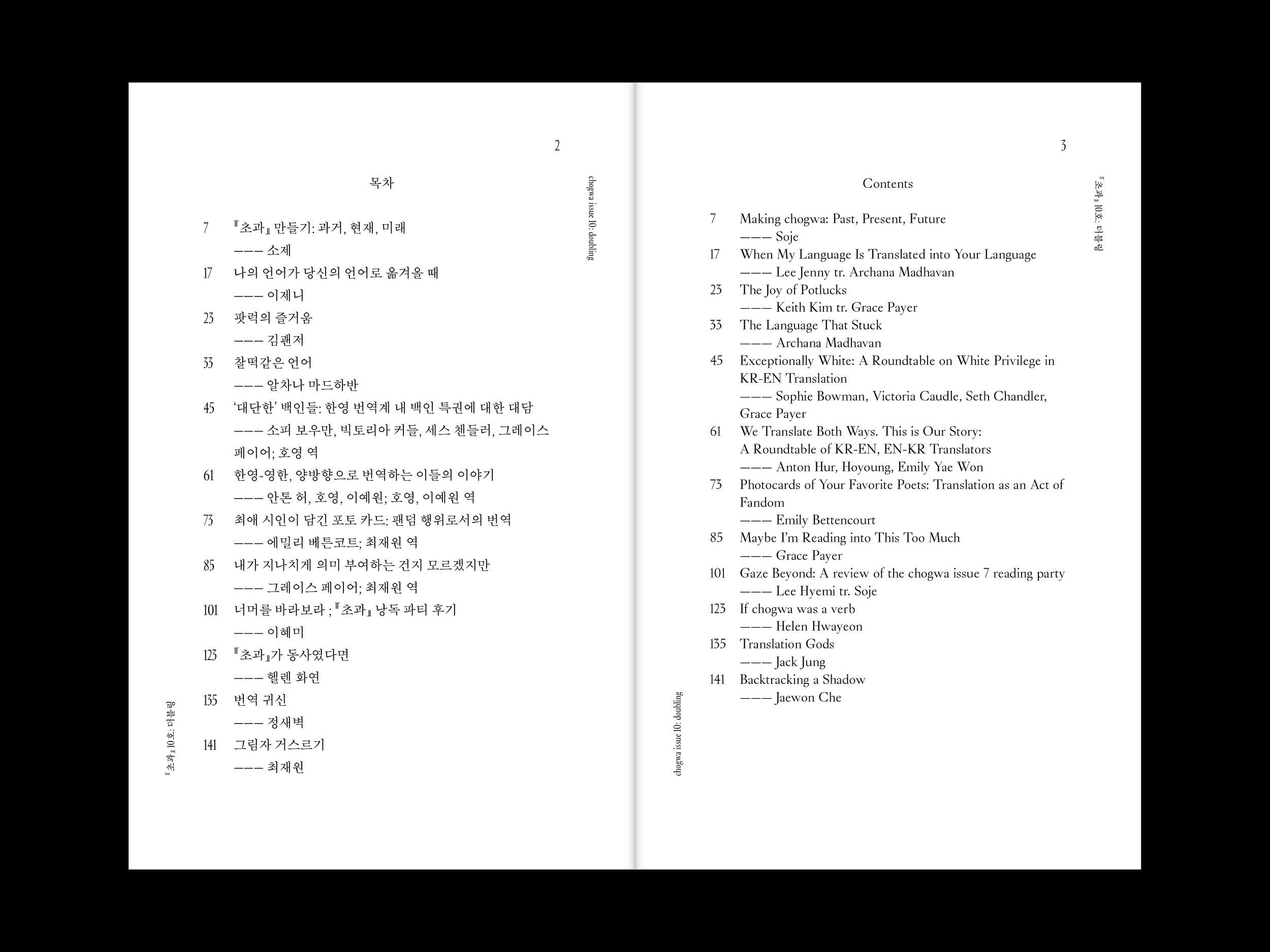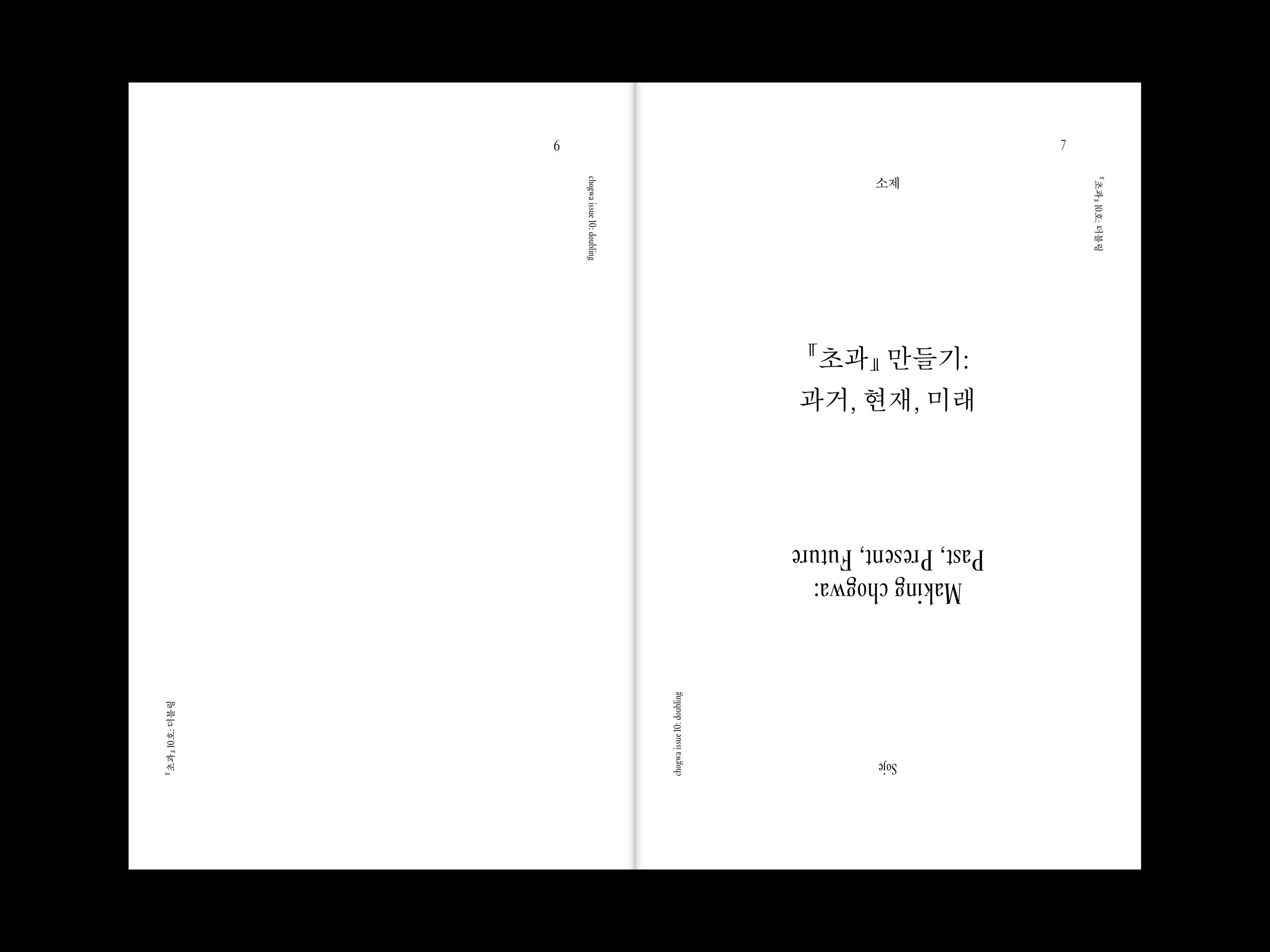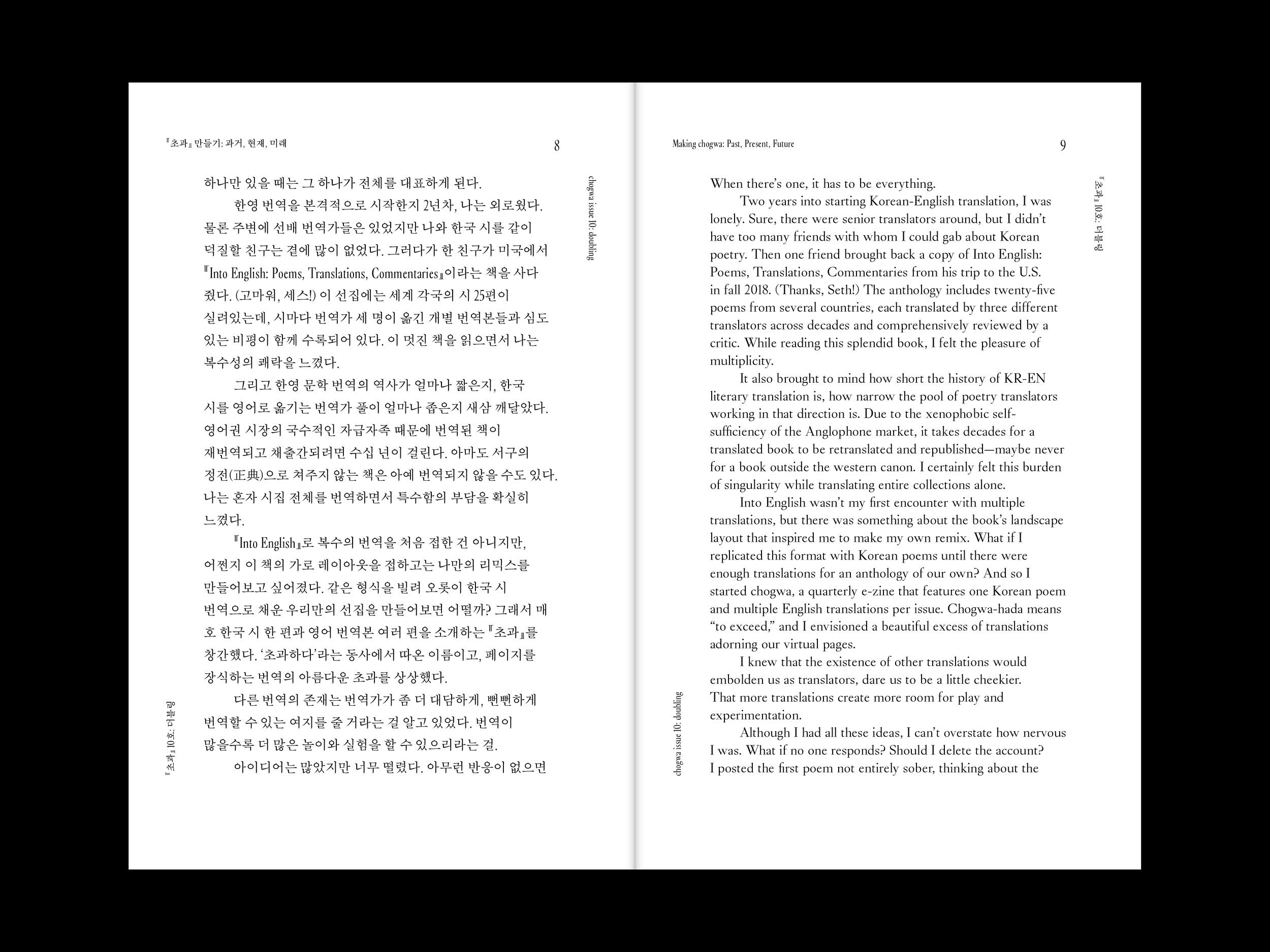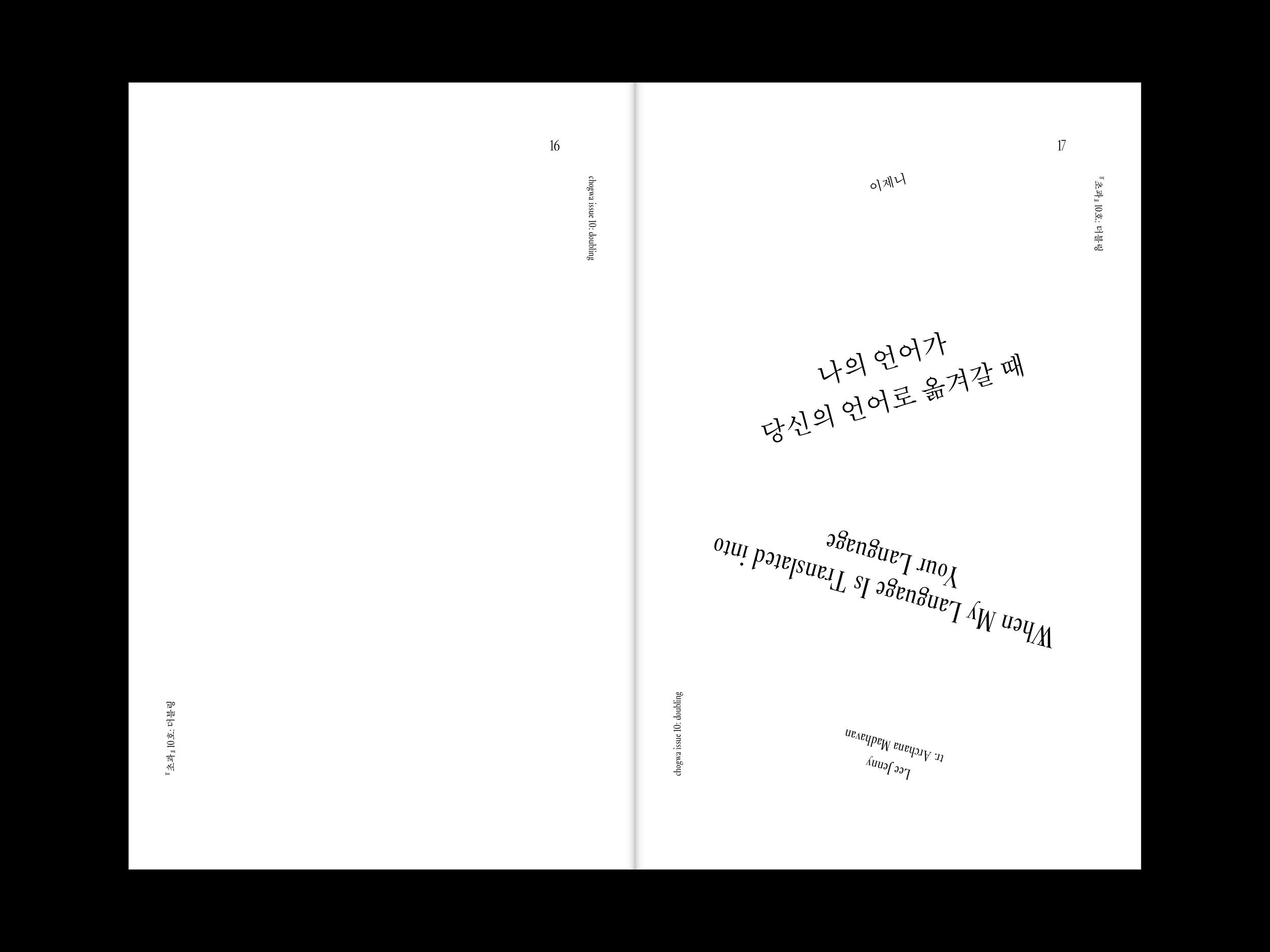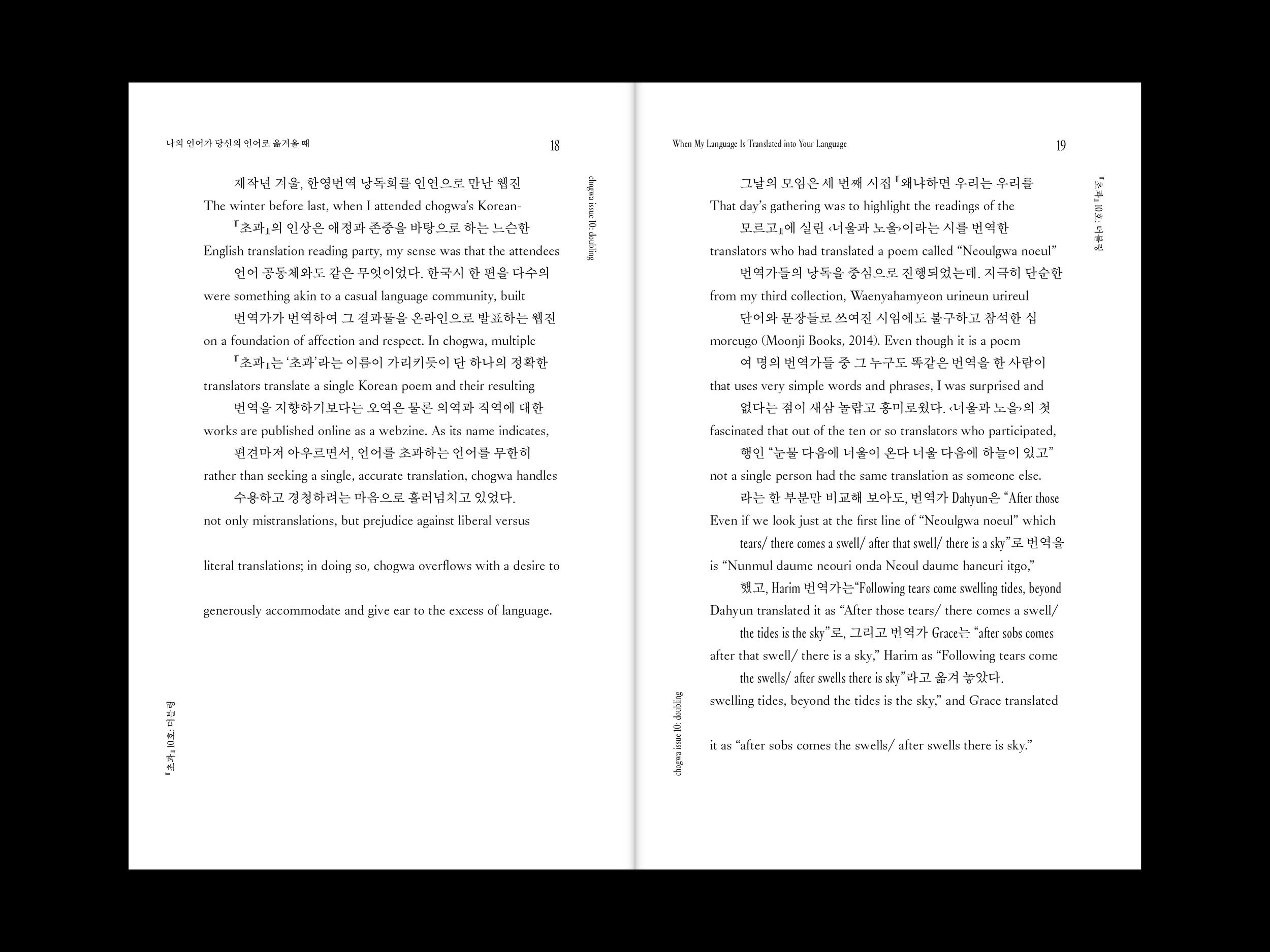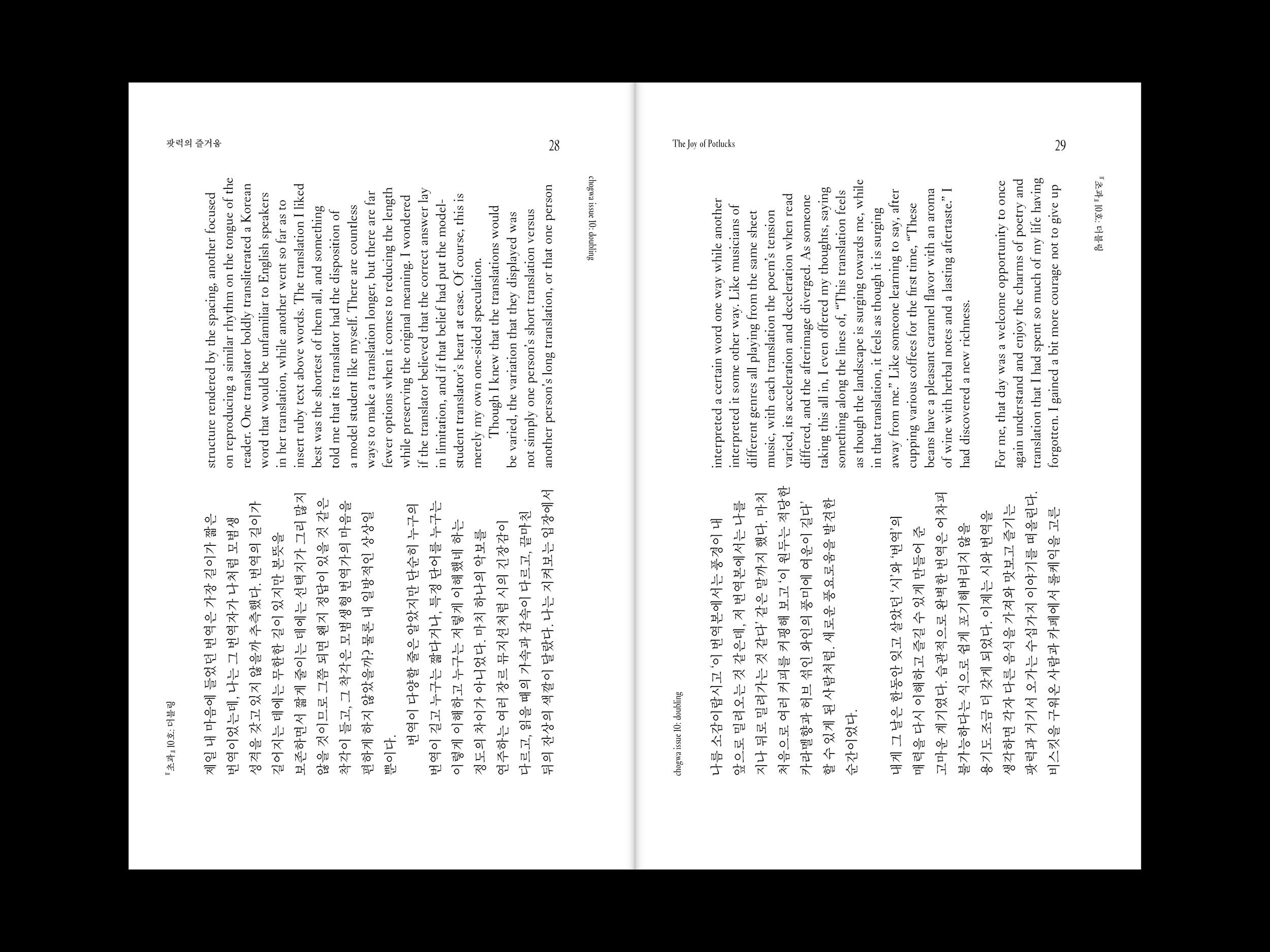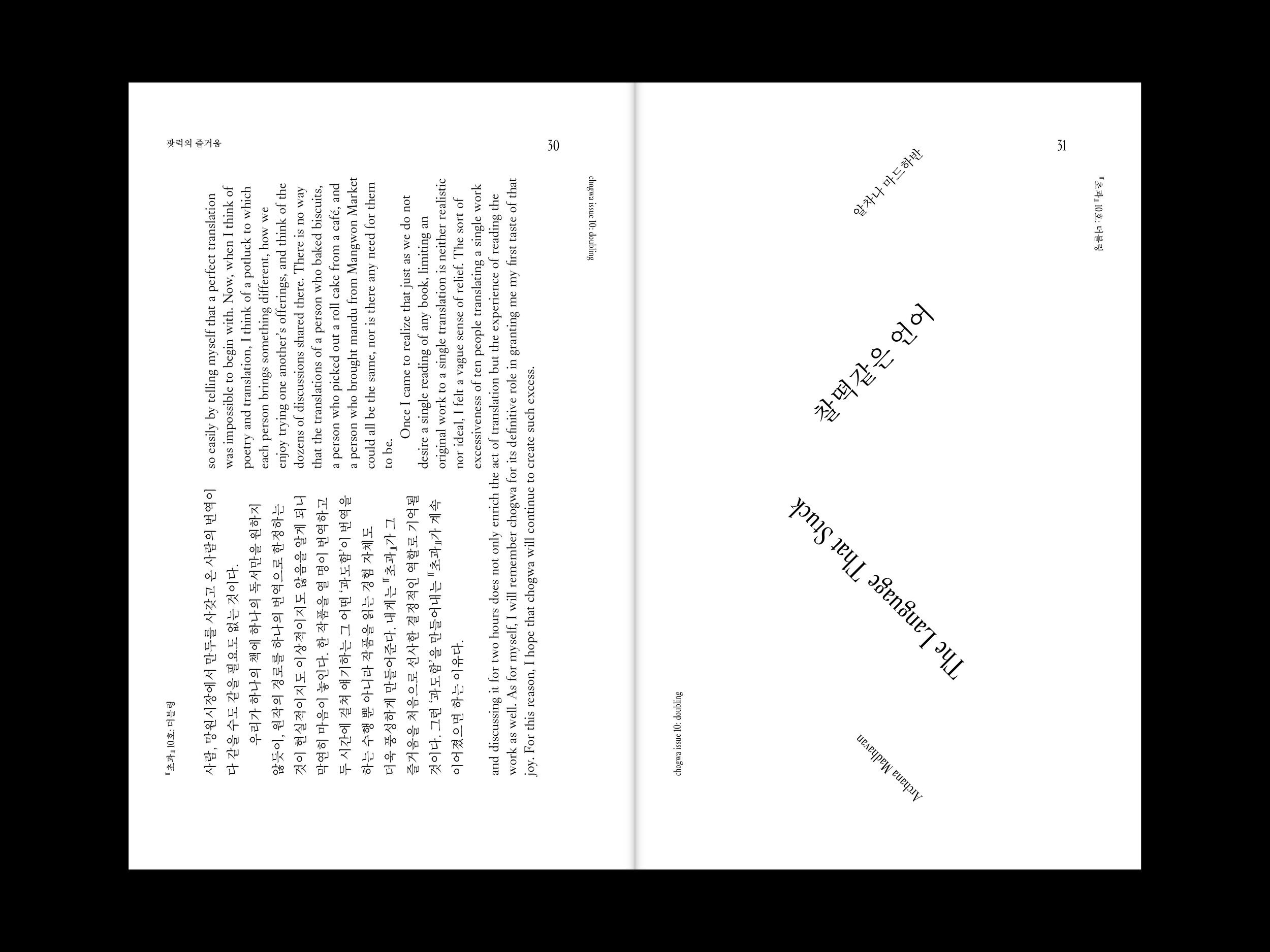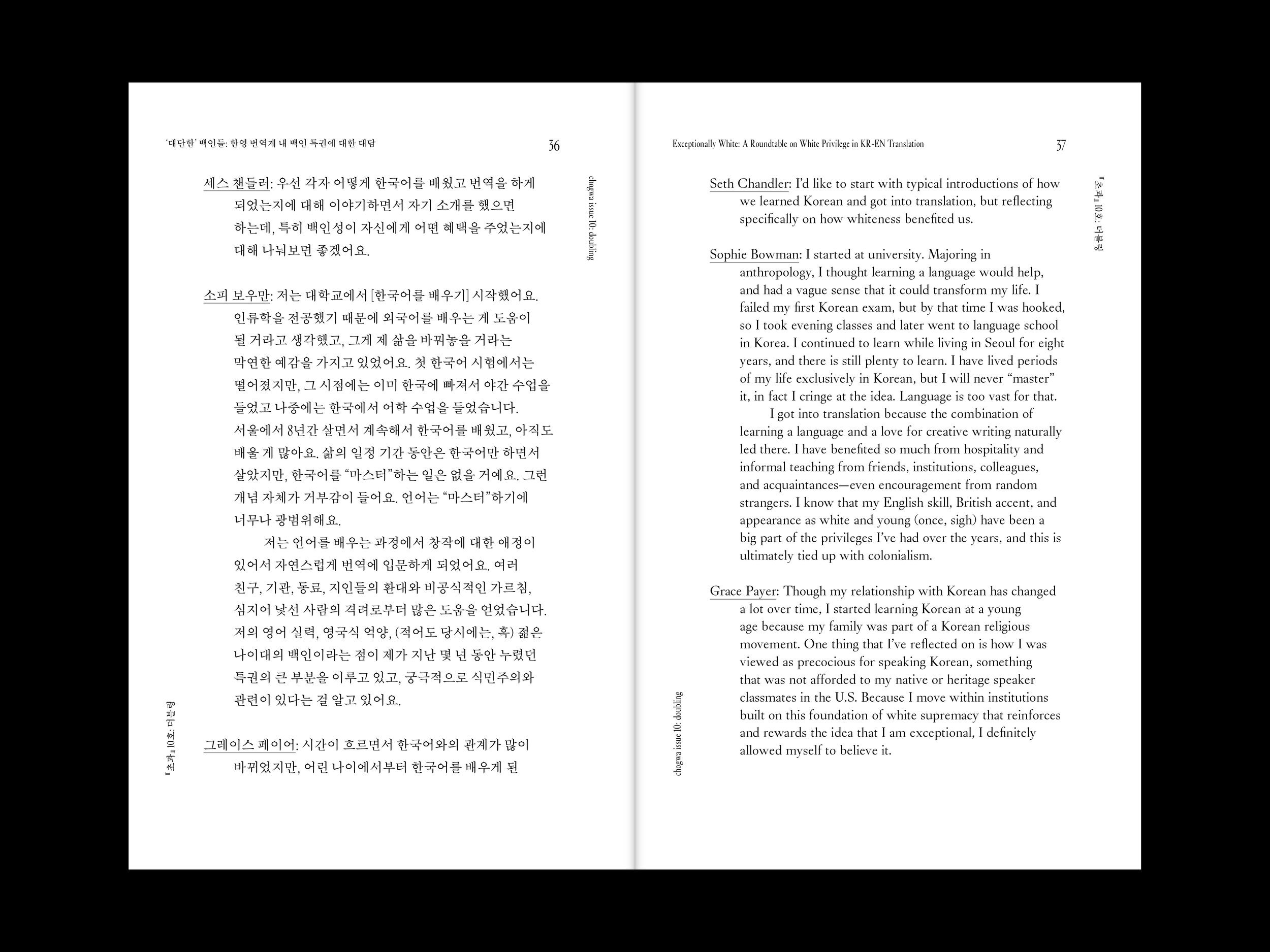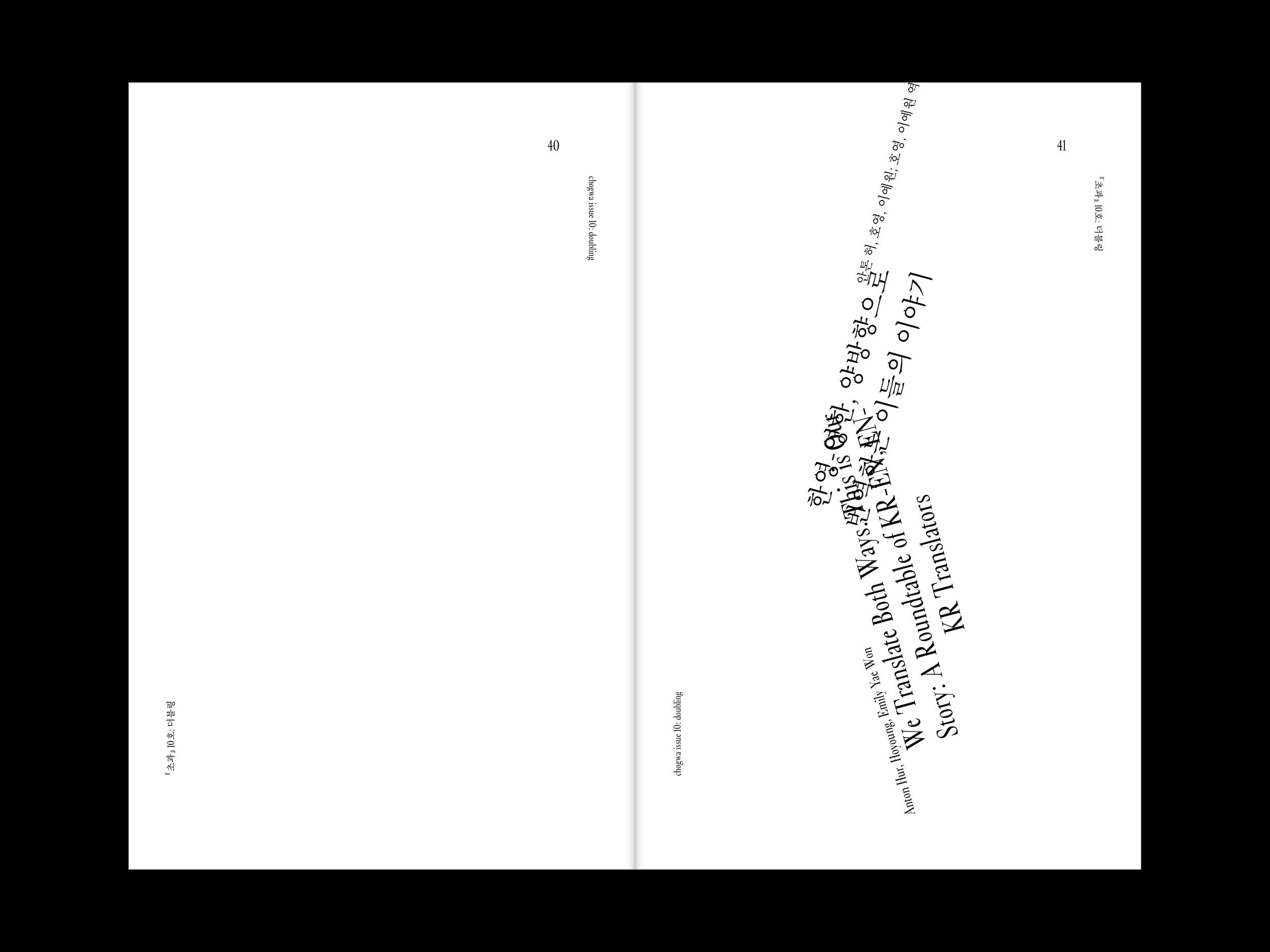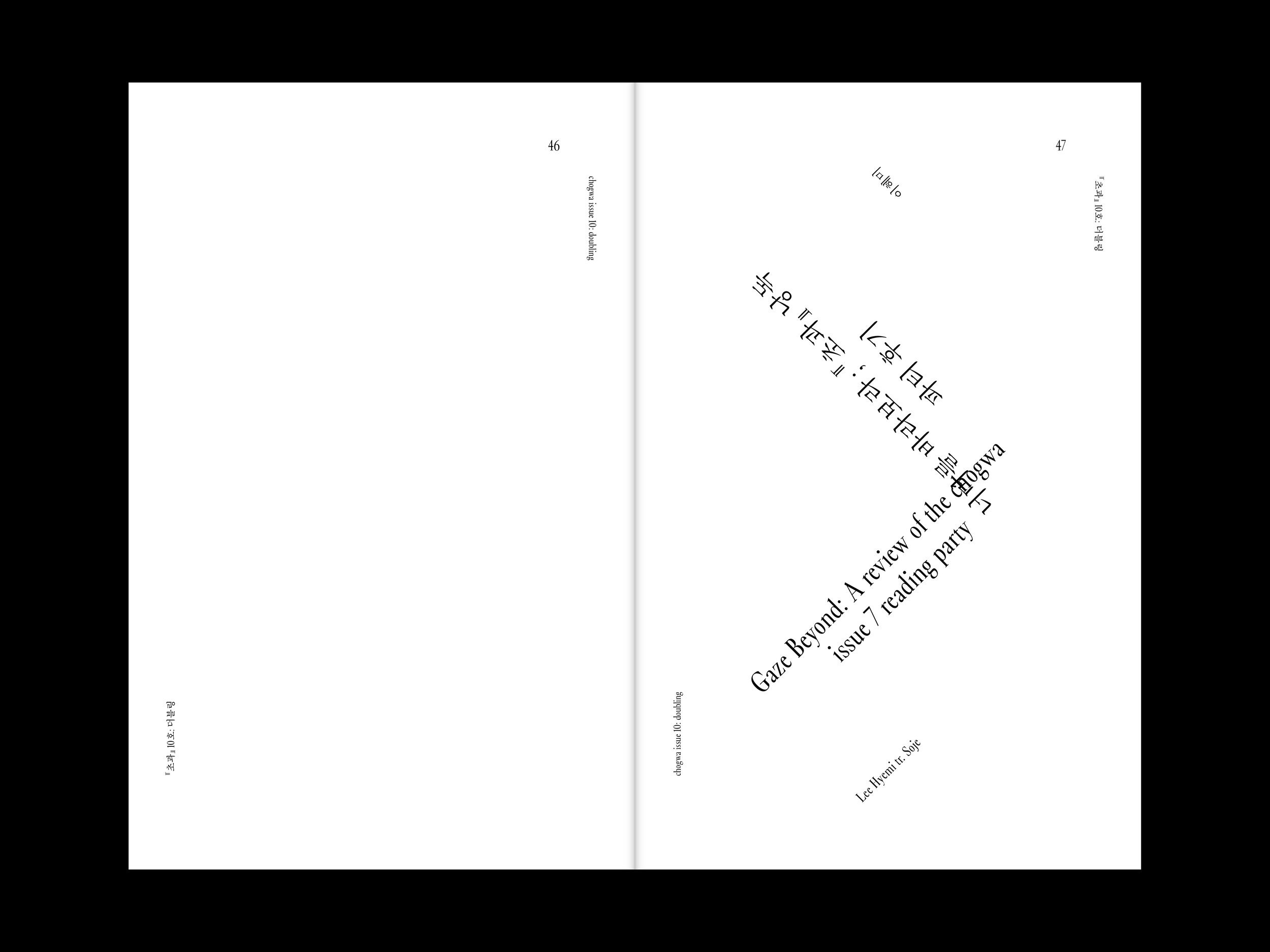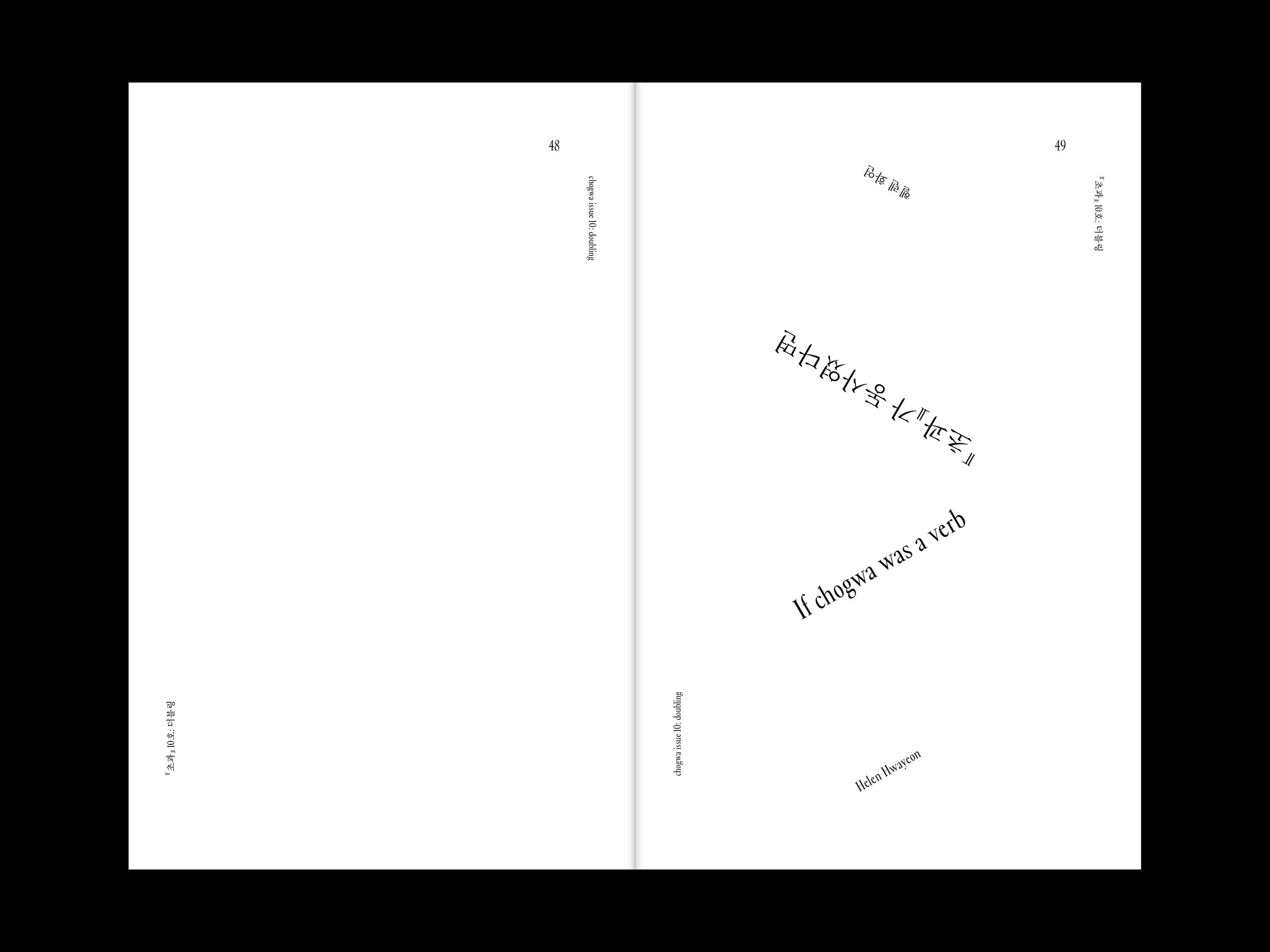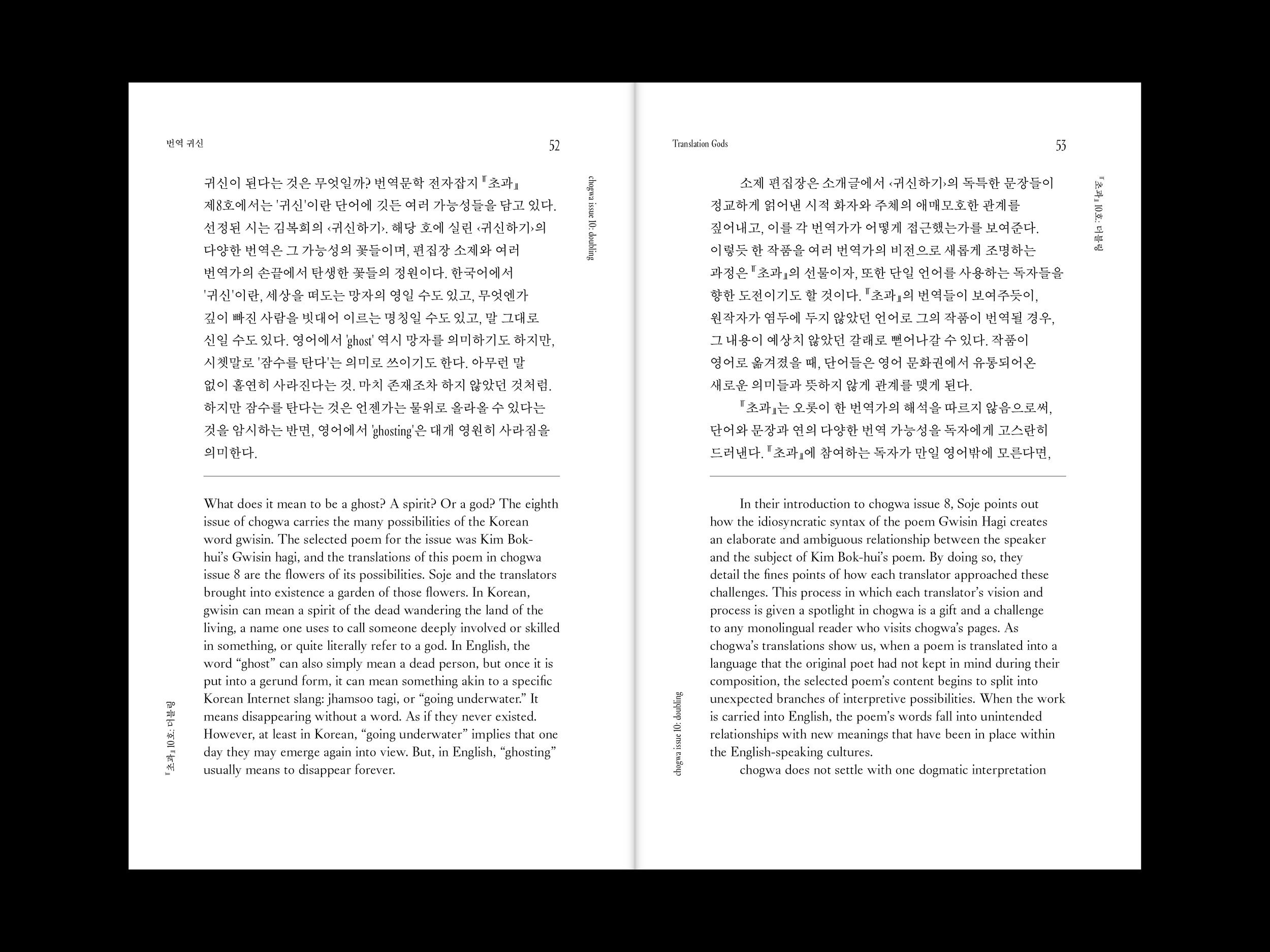chogwa issue 10: doubling (digital edition)
The tenth issue is a bilingual anthology of essays from chogwa contributors and readers.
An excerpt from Soje’s essay “Making chogwa: Past, Present, Future”
“For our events, I invite the poet, who most likely doesn’t speak English, and ask everyone to speak Korean. Korean poets have been curious about what exactly was being written about their poems, and I always wanted to give them the full chogwa experience, too.
Naturally, a bilingual issue was in order. The second anniversary, issue 10, seemed the perfect occasion to undertake such an endeavor. For this anthology of essays, I invited returning contributors, poets who’ve attended our events, and even readers to write about their various experiences with chogwa. This issue contains reviews of specific issues and events, personal essays/origin stories, and roundtable discussions on the politics of literary translation . . . times two!”
Table of Contents
1a. Soje - Making chogwa: Past, Present, Future
1b. 소제 - 『초과』 만들기: 과거, 현재, 미래
2a. 이제니 - 나의 언어가 당신의 언어로 옮겨올 때
2b. Lee Jenny tr. Archana Madhavan - When My Language Is Translated into Your Language
3a. 김괜저 - 팟럭의 즐거움
3b. Keith Kim tr. Grace Payer - The Joy of Potlucks
4a. Archana Madhavan - The Language That Stuck
4b. 알차나 마드하반 - 찰떡같은 언어
5a. Sophie Bowman, Victoria Caudle, Seth Chandler, Grace Payer - Exceptionally White: A Roundtable on White Privilege in KR-EN Translation
5b. 소피 보우만, 빅토리아 커들, 세스 첸들러, 그레이스 페이어; 호영 역 - ‘대단한’ 백인들: 한영 번역계 내 백인 특권에 대한 대담
6a. Anton Hur, Hoyoung, Emily Yae Won - We Translate Both Ways. This is Our Story: A Roundtable of KR-EN, EN-KR Translators
6b. 안톤 허, 호영, 이예원; 호영, 이예원 역 - 한영-영한, 양방향으로 번역하는 이들의 이야기
7a. Emily Bettencourt - Photocards of Your Favorite Poets: Translation as an Act of Fandom
7b. 에밀리 베튼코트; 최재원 역 - 최애 시인이 담긴 포토 카드: 팬덤 행위로서의 번역
8a. Grace Payer - Maybe I’m Reading into This Too Much
8b. 그레이스 페이어; 최재원 역 - 내가 지나치게 의미 부여하는 건지 모르겠지만
9a. 이혜미 - 너머를 바라보라 ; 『초과』 낭독 파티 후기
9b. Lee Hyemi tr. Soje - Gaze Beyond: A review of the chogwa issue 7 reading party
10a. Helen Hwayeon - If chogwa was a verb
10b. 헬렌 화연 - 『초과』가 동사였다면
11a. 정새벽 - 번역 귀신
11b. Jack Jung - Translation Gods
12a. 최재원 - 그림자 거스르기
12b. Jaewon Che - Backtracking a Shadow
Contributors
소제 (Soje) - 1.5세대 재미교포. UC 버클리에서 영문학을 공부하다가 한국 현대문학과 번역에 빠졌다. 이혜미 시집 『뜻밖의 바닐라』, 이소호 시집 『캣콜링』, 최진영 소설 『해가 지는 곳으로』를 영어로 번역했다. 트위터 @sojeflux
Soje is the translator of Lee Hyemi’s Unexpected Vanilla (Tilted Axis Press, 2020), Choi Jin-young’s To the Warm Horizon (Honford Star, 2021), and Lee Soho’s Catcalling (Open Letter Books, 2021).
이제니 - 시집 『아마도 아프리카』, 『왜냐하면 우리는 우리를 모르고』, 『그리하여 흘려 쓴 것들』가 있다. 제21회 편운문학상 시 부문 우수상, 제2회 김현문학패를 수상했다. 인스타그램 @dadapaper
Lee Jenny is the author of four poetry collections. She currently resides in Geoje Island and is a member of the experimental text collective ‘Ru’ with seven other South Korean writers.
김괜저 - 김괜저는 안양에 살며 사진, 글, 디자인 등을 생산하는 사람이다. 주로 걷거나 먹거나 영화를 보거나 트위터 또는 인스타그램에 있다. 텀블벅에서 일한다. 『연애와 술』을 썼다. 트위터 @gwenzhir/인스타그램 @keithskim
Keith Kim is a writer, photographer, and designer based in Seoul. Relationship and Drinks, his first collection of essays, was published in 2020.
알차나 마드하반 - 인도계 미국인. 한국어를 10년 넘게 공부해 왔다. 스탠포드 대학교에서 면역학을 공부하고 석사를 받았다. 현재 실리콘 밸리 소프트웨어 산업에 일하면서 한국 문학과 웹툰을 번역한다. 트위터 @chanamuu
Archana Madhavan is a writer and translator, who also juggles a career in tech. Her translations of Lee Jenny, Oh Han-ki, and Kim Hyun have appeared in Modern Poetry in Translation, Nabillera, Korean Literature Now, is forthcoming elsewhere. She currently lives in San Jose, California.
소피 보우만 - 소피 보우만은 백희나의 『알사탕』, 안경자와 이찬재의 『돌아보니 삶은 아름다웠더라』, 김보영의 『당신을 기다리고 있어』와 『당신에게 가고 있어』의 영역자다. 현재 토론토대학교 동아시아학과 박사생이다. 트위터 @SophieOrbital
Sophie Bowman is a PhD student in modern Korean literature. Her English translations of Korean literature, poetry, and literary criticism have appeared in various magazines and journals. Her latest book translations are Looking Back Life Was Beautiful (Penguin Random House, 2020) and I'm Waiting for You (Harper Voyager, 2021).
빅토리아 커들 - 빅토리아 커들은 현재 번역가로 활동하면서 UCLA의 동아시아 언어와 문화과에서 박사과정을 하고 있다. 서울대 국어국문과, 그리고 이스트 앵글리아 대학교 문학번역과를 졸업하고 석사를 받았다. 트위터/인스타그램 @nureonjongi
Victoria Caudle is a PhD student in Modern Korean Literature at UCLA. She received a BA honors in Korean from SOAS, University of London, an MA in Korean Language and Literature focusing on Modern Korean Literature from Seoul National University, and an MA in Literary Translation from the University of East Anglia.
세스 챈들러 - 세스 챈들러는 서울대 국문과에서 석사학위를 받았으며, 한국문학번역원 아카데미 과정을 이수했다. 공역가 김진아와 함께 제45회 '코리아타임즈 현대문학번역상'을 수상했다. 그의 번역 시는 '교차언어낭독회' 시리즈를 통해 발표되었고 하버드대 『아젤리아』지에 발표될 예정이다.
Seth Chandler is an academic and literary translator. He received his master's degree in modern Korean literature from Seoul National University and studied translation at the Korean Literature Translation Institute.
그레이스 페이어 - 서울대학교 사회학과 석사 수료했다. 김사과 작가의 단편소설 「매장」을 번역하여 제50회 코리아타임즈 한국현대문학번역상 우수상을 수상했다. 트위터 @thirtythirth
Grace Payer is a translator living in Korea. Her translation of Kim Sagwa's short story "Burial" was awarded a commendation prize at the 50th Korea Times translation awards.
안톤 허 - 한국 문학 번역가. 신경숙의 『리진』, 박상영의 『대도시의 사랑법』, 황석영의 『수인』 등을 번역하여 미국과 영국에 출판했다. 오션 브엉의 『Night Sky with Exit Wounds』 한국어 번역가이기도 하다. 트위터/인스타그램 @AntonHur
Anton Hur is one of the very few translators in the world who makes a full-time living translating Korean literature into English. He resides in Seoul.
이예원 - 이예원은 문학 번역가로 데버라 리비, 조애나 월시(플레이타임), 사뮈엘 베케트(워크룸 프레스)의 글을 한국어로 옮겼고 김숨, 이상우, 천희란, 한강의 단편소설과 황정은의 『계속해보겠습니다』와 『디디의 우산』(2023년 출간 예정)을 영어로 옮겼다. 트위터 @peagirin
Emily Yae Won is a literary translator based in Seoul. She has translated works by Ali Smith, Djuna Barnes, Jenni Fagan, Joanna Walsh and Deborah Levy into the Korean. Hwang Jungeun’s I’ll Go On is her first translation of a literary work from the Korean.
호영 - 서울과 미국의 소도시에서 자라고 문화인류학을 공부했다. 입말과 인터넷문화를 주로 번역한다. 옮긴 책으로는 『남은 인생은요? 』 (성 지음), 편집한 책으로는 소설 <붉은 등, 닫힌 문, 출구 없음> (김비 지음) 등이 있다. 트위터 @rekognition_f
Hoyoung Moon is a translator, editor, and lover of footnotes. They translated the Korean edition of What About the Rest of Your Life by sung and edited the novel 붉은 등, 닫힌 문, 출구 없음(Red Light, Shut Door, No Exit) by 김비Kim Bi among others.
에밀리 베튼코트 - 에밀리 베튼코트는 한국 문학과 시를 영어로 번역하는 번역가다. 한국문학번역원에서 2019년에 졸업하고 한-영 번역 활동을 시작했다. 에밀리가 번역한 이제니 선생님 시가 Puerto del Sol에, 나희덕 선생님 시가 Asymptote에 게재되었다. 비밀신서에서 출판된 차민주 작가님의 《BTS를 철학하다》도 영어로 번역했다. 트위터/인스타그램 @peonydust
Emily Bettencourt is a translator of Korean literature and poetry to English. They began translating in 2019 after graduating from KLTI. Emily's translations of Lee Jenny have appeared in Puerto del Sol, and their translations of Ra Heeduk have appeared in Asymptote. They are also the translator of Cha Minju's Philosophizing About BTS, published by Bimilsincer.
이혜미 - 건국대학교 국어국문학과를 졸업하고 고려대학교 국어국문학과 대학원 박사과정에 재학 중이다. 시집으로 『보라의 바깥』과 『뜻밖의 바닐라』가 있다. 인스타그램 @hyemi1501
Lee Hyemi is the author of Ultraviolet and Unexpected Vanilla. In 2006, at age 18, she became the youngest winner of the JoongAng Literary Newcomer’s Prize since 1963.
헬렌 화연 - 헬렌 화연은 작가이자 번역가이다. 서울에서 태어나 사춘기 때 가족들과 미국으로 이주하여 1.5 이민자로 성장한 후, 지금은 베를린과 뉴저지를 오가며 작업한다. 다언어주의 (multilingualism)에 관심이 많으며 번역이라는 행위를 통해 식민주의, 언어와 문화적 계급 등의 주제를 탐구한다. 트위터/인스타그램 @helenorhyk
Helen Hwayeon is a writer and translator from Seoul. In addition to chogwa, her translations and collaborative projects can be found in Aster(ix) Journal and in several exhibition catalogs, including Akademie Schloss Solitude in Germany and Arts Maebashi in Gunma, Japan.
정새벽 - 한국 시·산문 번역자. 2017년~2019년 아이오와 작가 워크숍에서 트루먼 카포티 장학생으로 시학 석사 학위를 받았다. 『Yi Sang: Selected Works』(Don Mee Choi 엮음, Wave Books, 2020)를 번역·출간했다. 트위터 @daybreakjung
Jack Jung is a graduate of the Iowa Writers’ Workshop, where he was a Truman Capote Fellow. His translations of Korean poet Yi Sang’s poetry and prose are published in Yi Sang: Selected Works by Wave Books. He is a Visiting Assistant Professor of English at Davidson College.
최재원 - 천체물리, 뇌, 회화를 공부했다. 보디빌딩과 가을에서 겨울 사이의 등산과 어느 때의 산책과 아무도 없는 집을 좋아한다. 웹툰 관련 일을 하며 글 쓰고 번역한다. 『초과』의 팬으로서 일하고, 김괜저와 뉴스레터 오버랩을 운영한다. 사이펀, Hyperallergic, Asymptote, Modern Poetry in Translation 등에 글과 번역을 기고했다.
Jaewon Che is a writer and translator. They studied physics, brains, and painting. They won the Newcomer Poetry Prize from the Author Village Press for “Most Beautiful Boy (가장 아름다운 소년)” and 8 other poems in 2019. Can be reached at jaewonche@gmail.com.
오혜진(오와이이) - 서울에서 활동하는 그래픽 디자이너이다. 스튜디오 오와이이(OYE)를 운영하며, 편집디자인, 일러스트레이션, 출판 프로젝트 등을 진행하고 있다. 인스타그램 @ohezin
Hezin O is a graphic designer based in Seoul, South Korea. She has been running a graphic design studio OYE since 2014, working primarily in the cultural field on graphic design, illustration and publishing projects. Instagram @ohezin
Sneak Peek #1: Anton Hur in “We Translate Both Ways. This is Our Story: A Roundtable of KR-EN, EN-KR Translators”
I actually started as an interpreter first, and for that you pretty much have to be bidirectional. Yes24 interviewed me recently for a feature on Korean literature in translation and they asked a question about what my translation “style” was, and I ended up saying I tend to translate very colloquially because of my simultaneous interpreting background. When I interpret, my ears are listening to the next sentence as my mouth is speaking the last one, and basically the same thing happens when I translate. My fingers are typing the last sentence, but my eyes have already moved on to the one after. Neither language feels like a second language. It’s like putting on different accents.
Sneak Peek #2: Grace Payer’s essay “Maybe I’m Reading into This Too Much”
While I looked through the homophones, I recognized similarities between their characters – the radical 亡(mang) for “perish” or “loss” or “disappear” (망할 망) was present in all of them (though it should be noted that its role is not always to impart meaning, but to guide pronunciation). I could not help myself from falling down the rabbit hole of looking at the oracle bone script for each character and the pictographic readings of them. What better source to tell me about hope than a script used for divination? In the bone script, mang (亡) was a pictogram of a broken sword, implying death or fleeing after defeat in battle. There are also those who read it as a compound ideogram of 兦 wherein a person (人) follows a long road (乚), running far away to hide from misfortune. What if this was what is meant by “wander away” (Stine An), “hitting the road” (grace), or “getting out of here” (Soje)?
Sneak Peek #3: Emily Bettencourt’s essay “Photocards of Your Favorite Poets: Translation as an Act of Fandom”
There was almost nothing I wouldn’t translate. From NatePann posts to the BigHit blog itself, I was committed to translating as much content as possible, and the English-speaking fandom was voracious. I wasn’t the first person to translate BTS content from Korean into English—there were other fans doing so well before I came on the scene. But I had a background in creative writing, a decent grasp on the Korean language, and a lot of free time, and that made me a good contributor to a growing body of translated BTS content. I was also uniquely positioned by living in Korea, which allowed me to translate content to which other fans might not have access. I translated RM’s contribution to the 2016 essay compilation Doing Hip Hop, for example, and a series of posts on BookDB’s blog about the intertextuality of BTS’ music. My dedication to translating as much content as I could earned me a following on Twitter, but in my day-to-day life I was reluctant to admit to it. Something about translating K-pop content seemed unserious, somehow, not like “real” translation.
Sneak Peek #4: Helen Hwayeon’s essay “If chogwa was a verb”
As I sat in front of the laptop before the reading, taking sips of coffee and waiting for the Zoom event to open, I could hear the wind swoosh past behind me through the windows. I saw the dark outlines of tree branches swaying outside back and forth, some shimmying vibrantly as if they were entranced under divine energy. It seemed the Chumui dokbang (the title of Lee Hyemi's poem in issue 7, which I translated as "Dance of Confinement") had already begun—out in the eerie, jet-black streets of pandemic Berlin. Finally, a little past 3 am CET, the window to the reading opened, and Soje and Lee Hyemi came on stage, as did the grid of windows lit up with contributors from many corners of the world. Soje and Lee Hyemi warmed the atmosphere with their glowing presence; I could feel the sun reflecting off the screen all the way from Lee Hyemi's studio in Gimpo; I knew then that our collective chum (dance) would look quite different from what was unfolding outside my window.
Sneak Peek #5: Seth Chandler and Victoria Caudle in “Exceptionally White: A Roundtable on White Privilege in KR-EN Translation”
SC: If you're not familiar with the field, it’s easy to be unaware of the work being done, and since white translators receive constant praise for our “exceptionality,” there's a real danger of thinking, “I'm the only person who can do this job.” But thanks to chogwa or the Smoking Tigers, a quick look around Twitter will show you that’s not the case.
Co-translation has also sometimes been used to fill in linguistic deficiencies, with the same gendered and racialized labor issues.
VC: There’s a classic, uncomfortable co-translator dynamic that mirrors romantic partnerships between a white man and a Korean woman, where the woman’s unseen labor covers for the man’s questionable or even nonexistent level of Korean. Sometimes the white co-translator is just editing a draft that's written by their co-translator, and how does that editing count as translating? It's hard enough to get a translator’s name on a book, so the labor distribution issue in co-translation is even more difficult and sometimes perhaps deliberately hidden or misconstrued.
Sneak Peek #6: Archana Madhavan’s essay “The Language That Stuck”
Linguistically, Indic languages are not known to be closely related to Korean. But Korean has enough similarities to Marathi not only phonetically, but morphologically, too, that it made grasping the language intuitive. Both are agglutinative, subject-object-verb languages, where verbs often bear the burden of meaning. What would be multi-word sentences in English is conveyed simply by adding affixes to verb roots. For example, in the phrase 밥 먹을까? may be translated to “Shall we eat?” in English. The ㄹ까 ending indicates a suggestion which is conveyed by the words “shall we” in English. Marathi is more similar to Korean, in that instead of using a different word to indicate suggestion, it also has a verb ending that attaches to the verb root of eat खा (kha). By happy coincidence, sometimes helping verbs in the two languages carry similar meanings as well. In Marathi, टाक (tak) and दे (de) mean 버리다 and 주다 respectively, and convey similar meaning as helping verbs. And the use of the Korean 하다 with various nouns, came naturally to me as the same construction existed with the Marathi verb कर (kar). Both languages had formal and informal speech, honorifics and kinship terms. The word जी (ji) which is shared across a number of Indian languages is similar in meaning to 님, for instance.


